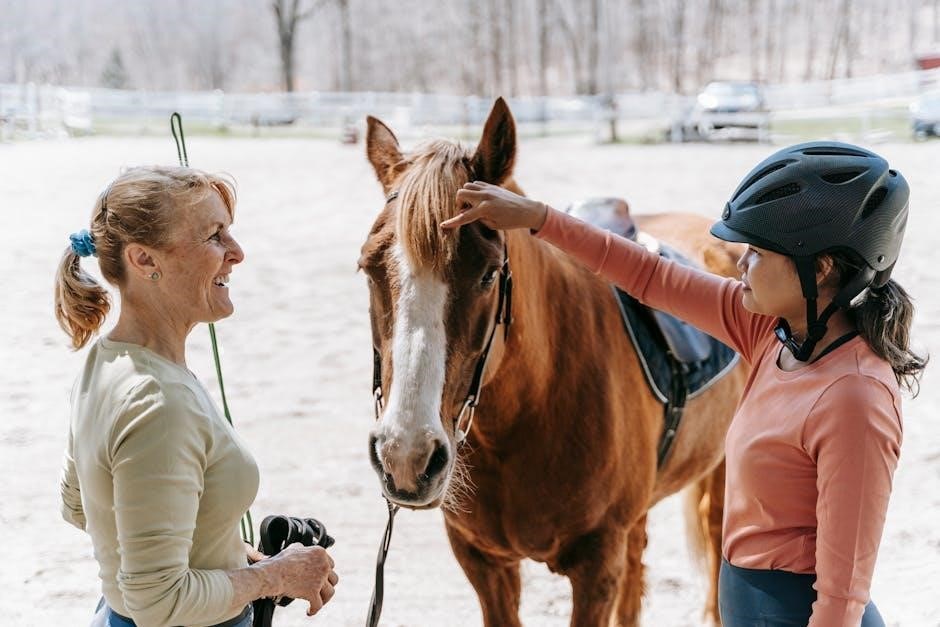Generalization in learning refers to the ability to apply skills across diverse contexts, environments, and people. Teaching with multiple instructions enhances this by exposing learners to varied cues and settings, fostering real-world application and functional communication skills.
1.1 Understanding the Concept of Generalization
Generalization refers to the ability to apply learned skills or behaviors across different contexts, environments, and people. It involves transferring knowledge from one situation to another, making it functional in real-world settings. When learners are taught using multiple instructions, they are exposed to a variety of cues, examples, and scenarios. This diversity helps them understand the broader applicability of the skills being taught, reducing reliance on specific prompts or environments. Effective generalization ensures that learning is not limited to the training context but can be naturally applied in everyday life.
1.2 The Importance of Generalization in Skill Acquisition
Generalization is crucial for ensuring that learned skills are not limited to specific training contexts. It enables learners to apply knowledge naturally across diverse environments, people, and situations. Without generalization, skills may remain context-dependent, reducing their practical value. Teaching with multiple instructions exposes learners to varied cues and scenarios, fostering adaptability and real-world application. This approach enhances learning outcomes by ensuring skills are functional and transferable, a cornerstone of effective skill acquisition and communication development.
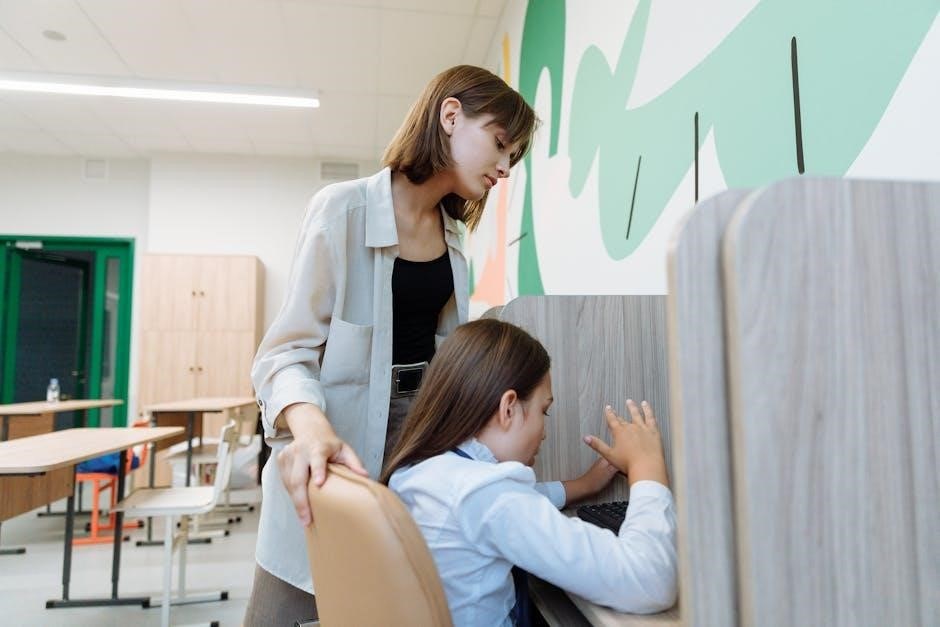
The Role of Multiple Instructions in Teaching
Multiple instructions expose learners to diverse contexts and cues, aiding in real-world application and effective communication. This approach ensures skills are adaptable and transferable across environments.
2.1 Definition of Multiple Instructions
Multiple instructions refer to the use of varied teaching methods, examples, and communication partners to expose learners to diverse contexts. This approach enhances skill acquisition by providing multiple cues and settings, ensuring learners can apply what they learn in different environments. By incorporating varied examples and real-life situations, multiple instructions prepare learners for the diversity of real-world interactions, where they encounter different people, settings, and stimuli. This methodology is crucial for promoting generalization, as it helps learners understand how to adapt skills across various scenarios.
2.2 How Multiple Instructions Expose Learners to Diverse Contexts
Multiple instructions expose learners to diverse contexts by presenting skills in varied settings, with different people, and using various stimuli. This approach mimics real-life interactions, where learners encounter multiple cues and scenarios; By practicing skills in different environments, learners develop adaptability, ensuring they can apply what they learn across various situations. This exposure to diversity enhances the ability to generalize, making skills functional and applicable in real-world contexts, which is essential for effective learning and independence.
Promoting Generalization Through Multiple Exemplars
Multiple exemplars expose learners to varied examples, enhancing their ability to apply skills across contexts. This approach ensures adaptability and real-world application of learned behaviors.
3.1 The Concept of Multiple-Exemplar Training
Multiple-exemplar training involves teaching a skill using various examples to broaden understanding. This method ensures learners can apply skills across different contexts by exposing them to diverse stimuli, people, and environments. Research shows that varied instructional histories enhance generalization, as learners learn to respond to multiple cues rather than a single prompt. This approach is particularly effective in teaching functional communication and social skills, as it mimics real-life interactions and promotes adaptability.
3.2 Case Studies Highlighting the Effectiveness of Multiple Exemplars
Case studies demonstrate that multiple-exemplar training significantly enhances generalization. For instance, teaching sharing behaviors in children with autism using varied examples increased verbal sharing across settings. Research by Bryant and Budd (1984) showed that breaking sharing into components (offers, requests, acceptances) and using multiple exemplars improved generalization. These studies underscore how diverse instructional examples promote skill application in real-world contexts, making learning more adaptable and functional.
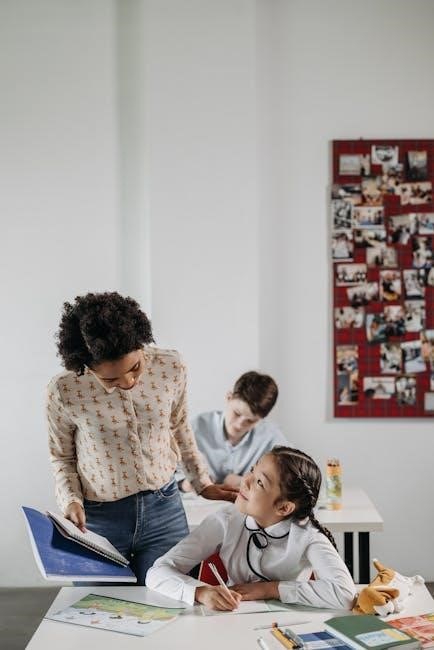
Natural Environment Training (NET)
Natural Environment Training (NET) involves teaching skills in real-world settings, promoting practical application. Incorporating natural routines enhances learning and generalization across diverse contexts effectively.
4.1 Teaching Skills in Real-World Settings
Teaching skills in real-world settings is fundamental for effective generalization. By incorporating natural environments, learners engage in authentic situations, enhancing their ability to apply skills across diverse contexts. This approach ensures that skills are functional and relevant, promoting better retention and practical use. Real-world training bridges the gap between instructional settings and everyday life, making learning more meaningful and adaptable.
4.2 Enhancing Generalization by Incorporating Natural Routines
Incorporating natural routines into instruction enhances generalization by aligning learning with real-life scenarios. This approach ensures that skills are practiced in contexts where they are most applicable, fostering their practical use. Natural routines provide varied cues and settings, encouraging learners to adapt skills across different situations. By embedding instruction within daily activities, learners develop the ability to generalize more effectively, making their skills functional and meaningful in everyday life.
Using Multiple Stimuli and People
Using diverse stimuli and people exposes learners to varied cues, mimicking real-life interactions. This enhances generalization by teaching learners to respond across different contexts and instructors.
5.1 The Impact of Diverse Stimuli on Learning
Diverse stimuli expose learners to varied cues, enhancing their ability to generalize skills across different contexts. By encountering multiple examples and settings, learners develop a robust understanding of how skills apply in real-world situations. This approach reduces reliance on specific prompts and fosters adaptability, ensuring skills are functional and applicable beyond the training environment. The use of varied stimuli and people mimics real-life interactions, making learning more dynamic and effective for generalization.
5.2 Involving Multiple Instructors to Mimic Real-Life Interactions
Incorporating multiple instructors exposes learners to diverse communication styles and personalities, simulating real-life interactions. This variety helps learners understand that skills are not context-specific but universally applicable. By interacting with different people, learners develop the ability to adapt their responses to various social cues and environments. This approach strengthens generalization by ensuring that skills are not limited to a single instructor or setting, making them more functional and transferable to everyday situations.
Evidence-Based Approaches to Generalization
Evidence-based methods like the PEAK-G module and multiple-exemplar training enhance generalization by exposing learners to diverse stimuli and instructional histories, promoting skill application across varied contexts effectively.
6.1 The PEAK-G Module for Advanced Knowledge Generalization
The PEAK-G module is a comprehensive approach designed to promote advanced knowledge generalization. By incorporating multiple exemplars and diverse instructional strategies, it enables learners to apply skills across various contexts. Research indicates that PEAK-G effectively enhances generalization by exposing learners to different stimuli and settings, ensuring skills are functional in real-world environments. This module emphasizes the importance of varied instructional histories to support long-term retention and application of learned behaviors.
6.2 Research Findings on Instructional Histories and Generalization
Research highlights the critical role of instructional histories in promoting generalization. Learners exposed to varied instructional strategies and multiple exemplars demonstrate improved skill application across diverse contexts. Studies suggest that diverse training stimuli and settings enhance the likelihood of generalization. Instructional histories that incorporate multiple cues and real-world scenarios foster robust learning outcomes. These findings emphasize the importance of structured, varied teaching methods to ensure skills are functional and transferable beyond the training environment.
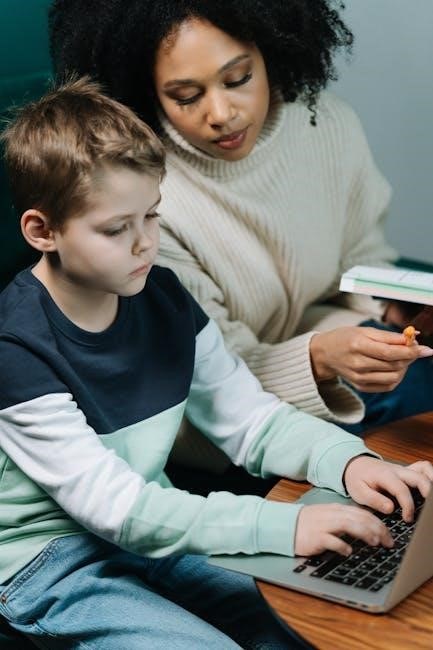
Teaching Functional Communication Skills
Teaching functional communication skills involves using multiple instructions to help learners generalize by practicing in diverse settings and real-world contexts, enhancing their ability to apply skills broadly.
7.1 Applying Multiple Instructions to Develop Communication Skills
Applying multiple instructions in teaching communication skills exposes learners to diverse cues and contexts. This approach encourages the development of functional communication by simulating real-life interactions, enhancing generalization. Learners practice responding to varied prompts, ensuring they can apply skills across environments and communication partners. For instance, using different instructors and settings during training helps learners adapt their communication strategies, making them more versatile and effective in real-world situations.
7.2 Encouraging Functional Use of Skills Across Environments
Encouraging the functional use of skills across environments involves teaching in real-world settings where behaviors naturally occur. By incorporating varied routines and multiple instructional contexts, learners develop the ability to apply skills adaptively. This approach ensures that skills are not limited to one environment but are usable in diverse situations, promoting practical and meaningful generalization. Real-life application strengthens the learner’s ability to function effectively in everyday interactions, making skills more versatile and enduring.

The Role of Diverse Settings in Learning
Diverse settings expose learners to varied contexts, enhancing their ability to apply skills in real-world situations. This promotes generalization by preparing learners for different environments naturally.
8.1 Varying Instructional Environments to Promote Generalization
Varying instructional environments exposes learners to diverse contexts, enhancing their ability to apply skills across different settings. By teaching in multiple locations and scenarios, learners encounter varied cues, such as different instructors, settings, and stimuli. This exposure helps bridge the gap between controlled learning environments and real-world situations, fostering generalization. For instance, practicing a skill in both a classroom and a park prepares learners to use it naturally in various contexts, making their skills more adaptable and functional in everyday life.
8.2 Examples of Successful Generalization Across Different Settings
Examples of successful generalization include learners applying skills learned in one environment to entirely new settings. For instance, a child with autism who learns communication skills in a classroom may later use them at home or in a park. Similarly, employees trained in a workshop might effectively apply their skills on a job site. These successes highlight how exposure to multiple instructions and diverse environments enhances the ability to generalize skills across different contexts, making learning more adaptable and functional in real-world situations.
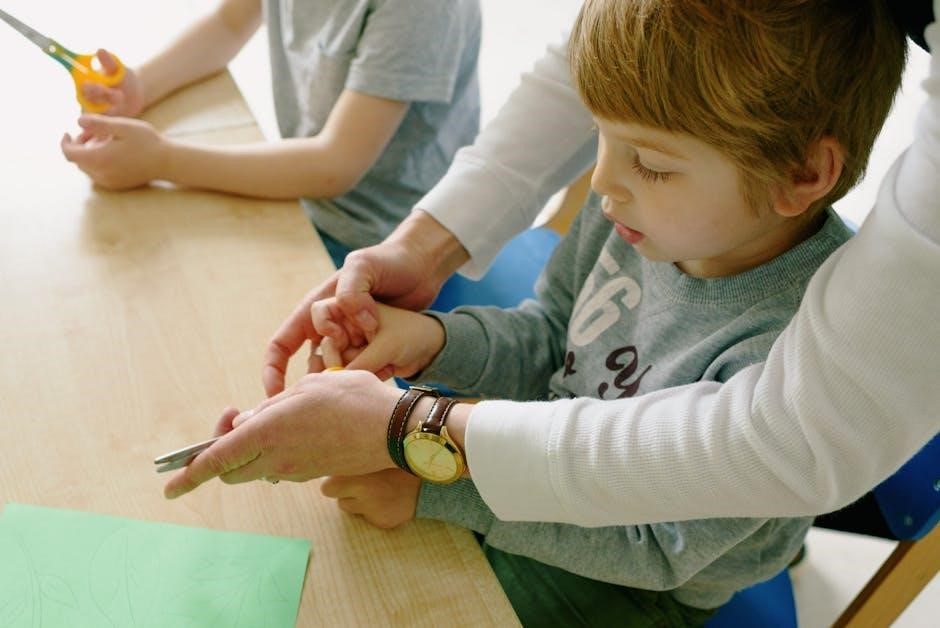
Strategies for Implementing Multiple Instructions
Strategies include varying instructional environments, incorporating diverse teaching methods, and involving multiple communication partners to expose learners to varied cues and settings, enhancing real-world application and adaptability;
9.1 Incorporating Varied Communication Partners
Incorporating varied communication partners exposes learners to diverse speaking styles, vocabularies, and interaction methods. This mimics real-life interactions, where individuals encounter multiple people and conversational cues. By engaging with different partners, learners practice responding to varied prompts, questions, and scenarios, enhancing their ability to generalize skills across environments. Role-playing with diverse partners also encourages adaptability, fostering functional communication in real-world settings. This strategy ensures learners are prepared for unpredictable social interactions, making their skills more versatile and applicable in everyday life.
9.2 Using Real-Life Situations as Instructional Tools
Using real-life situations as instructional tools bridges the gap between learning and application. By teaching skills within authentic contexts, learners practice in environments where they naturally occur. This approach enhances generalization by allowing learners to apply skills spontaneously across various settings. Real-life scenarios also incorporate diverse stimuli and interactions, mimicking the complexity of everyday life. This method not only makes learning more engaging but also ensures that skills are functional and relevant, preparing learners for real-world challenges and fostering long-term retention of acquired abilities.
Overcoming Barriers to Generalization
Teaching with multiple instructions addresses barriers by exposing learners to diverse cues and real-life situations, reducing reliance on single contexts and enhancing skill application across environments.
10.1 Identifying Common Challenges in Promoting Generalization
Common challenges in promoting generalization include overreliance on specific instructors, settings, or stimuli, which can limit skill application in diverse contexts. Learners may struggle with transferring skills to real-world situations due to insufficient exposure to varied environments. Additionally, inconsistent feedback and lack of opportunities to practice across multiple scenarios can hinder generalization. Addressing these barriers is crucial to ensure learners can apply skills broadly and effectively.
10;2 Practical Solutions to Enhance Generalization Outcomes
To enhance generalization outcomes, incorporate varied communication partners and real-life scenarios during instruction. Use multiple stimuli and settings to mimic natural interactions, ensuring learners practice skills in diverse contexts. Provide consistent, constructive feedback across all instructional situations to reinforce skill application. Periodically assess generalization progress and adjust teaching strategies as needed to address individual learner needs and promote successful skill transfer.
The Role of Feedback in Generalization
Constructive feedback across multiple instructions helps learners apply skills in diverse contexts. Tailoring feedback strategies ensures learners understand how to generalize behaviors effectively in various situations.
11.1 Providing Constructive Feedback Across Multiple Instructions
Constructive feedback is essential when teaching with multiple instructions, as it guides learners to understand how their responses align with desired outcomes. By providing specific, timely, and positive reinforcement, instructors help learners identify strengths and areas for improvement. Feedback should be tailored to the diverse contexts presented in multiple instructions, ensuring learners can apply skills across various settings. This approach fosters a deeper understanding and enhances the ability to generalize behaviors effectively in real-world situations.
11.2 Adjusting Feedback Strategies for Diverse Learners
Feedback strategies must be tailored to meet the unique needs of diverse learners. By customizing feedback delivery, timing, and content, instructors can ensure that learners understand and apply skills effectively. For some, frequent, specific feedback may be necessary, while others may benefit from intermittent reinforcement. Incorporating feedback within natural routines and real-life contexts enhances generalization. Adjusting feedback strategies ensures that all learners, regardless of their abilities or learning styles, can progress and apply skills across multiple instructions and environments successfully.
Case Studies on Effective Generalization Strategies
Case studies demonstrate how multiple instructions, diverse settings, and natural routines successfully promote generalization. Real-world examples, like PEAK-G and NET, highlight practical strategies for skill application across environments.
12.1 Successful Implementation of Multiple Instructions in ABA
Case studies in ABA demonstrate that using multiple instructions significantly enhances generalization. For example, the PEAK-G module effectively promotes advanced language skills by exposing learners to diverse exemplars and contexts. Natural Environment Training (NET) further supports this by teaching skills in real-world settings, ensuring learners can apply them naturally. By incorporating varied stimuli, settings, and instructors, ABA practitioners create rich learning environments that mimic real-life interactions, fostering functional communication and skill application across environments. These strategies highlight the practical benefits of multiple instructions in achieving meaningful generalization outcomes.
12.2 Real-World Examples of Generalization in Educational Settings
Educational settings provide practical examples of generalization through multiple instructions. For instance, a classroom teacher using varied communication partners and real-life situations helps students apply skills across environments. Incorporating group activities and individualized tasks ensures learners practice in diverse contexts. Home assignments that mirror classroom instructions further reinforce skill application. These strategies demonstrate how multiple instructions help learners generalize skills effectively, preparing them for real-world challenges and fostering functional communication across different settings and interactions.

Future Research Directions
Future research should investigate the long-term effects of multiple instructions on generalization, focusing on how prior instructional histories influence responding to test stimuli and acquisition across diverse contexts.
13.1 Investigating the Long-Term Effects of Multiple Instructions
Future research should explore how multiple instructions impact long-term generalization, focusing on instructional histories and their influence on responding to diverse stimuli and settings over time. This could reveal how prior learning experiences shape a learner’s ability to apply skills across contexts. Studies could also examine whether the effects of multiple instructions persist beyond initial training phases, providing insights into durability and maintenance of generalized behaviors; Such findings would help refine teaching strategies and improve outcomes for learners in various educational and therapeutic settings.
13.2 Exploring the Impact of Instructional Histories on Generalization
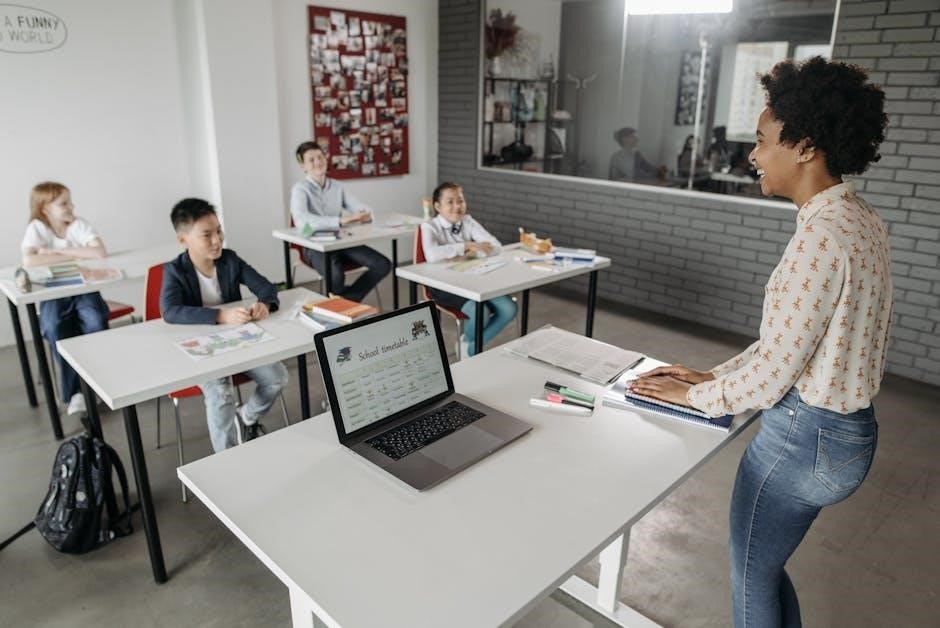
Research should examine how instructional histories shape a learner’s ability to generalize skills. Understanding how prior teaching methods influence responses to diverse stimuli and settings could reveal why certain skills generalize more effectively than others. This exploration could also clarify how train-and-test methods impact acquisition and generalization. By identifying patterns in instructional histories, educators can refine teaching strategies to better support learners in applying skills across varied contexts, ultimately enhancing long-term outcomes and fostering more robust generalization capabilities.
Teaching with multiple instructions effectively promotes generalization by exposing learners to diverse cues and contexts, enhancing real-world application and fostering functional communication skills across varied environments and people.
14.1 Summarizing the Benefits of Multiple Instructions
Teaching with multiple instructions offers significant benefits for generalization, as it exposes learners to diverse cues, settings, and communication partners. This approach enhances the ability to apply skills across various contexts and environments, making learning more functional and adaptable. By incorporating varied examples and real-world scenarios, multiple instructions prepare learners to respond effectively in different situations, fostering independence and practical communication skills. This method ensures that learners can generalize their knowledge and behaviors beyond controlled environments, achieving meaningful real-world application.
14.2 Final Thoughts on Promoting Generalization
Promoting generalization through multiple instructions is a powerful strategy that enhances learners’ ability to apply skills across diverse contexts. By incorporating varied settings, stimuli, and communication partners, educators ensure that learning is adaptable and functional. Evidence-based approaches, such as Natural Environment Training and multiple-exemplar training, have proven effective in fostering real-world application. Continuous feedback and tailored instructional strategies further support this process. Ultimately, these methods create a robust foundation for learners to generalize skills effectively, making them more independent and capable in real-life situations.

